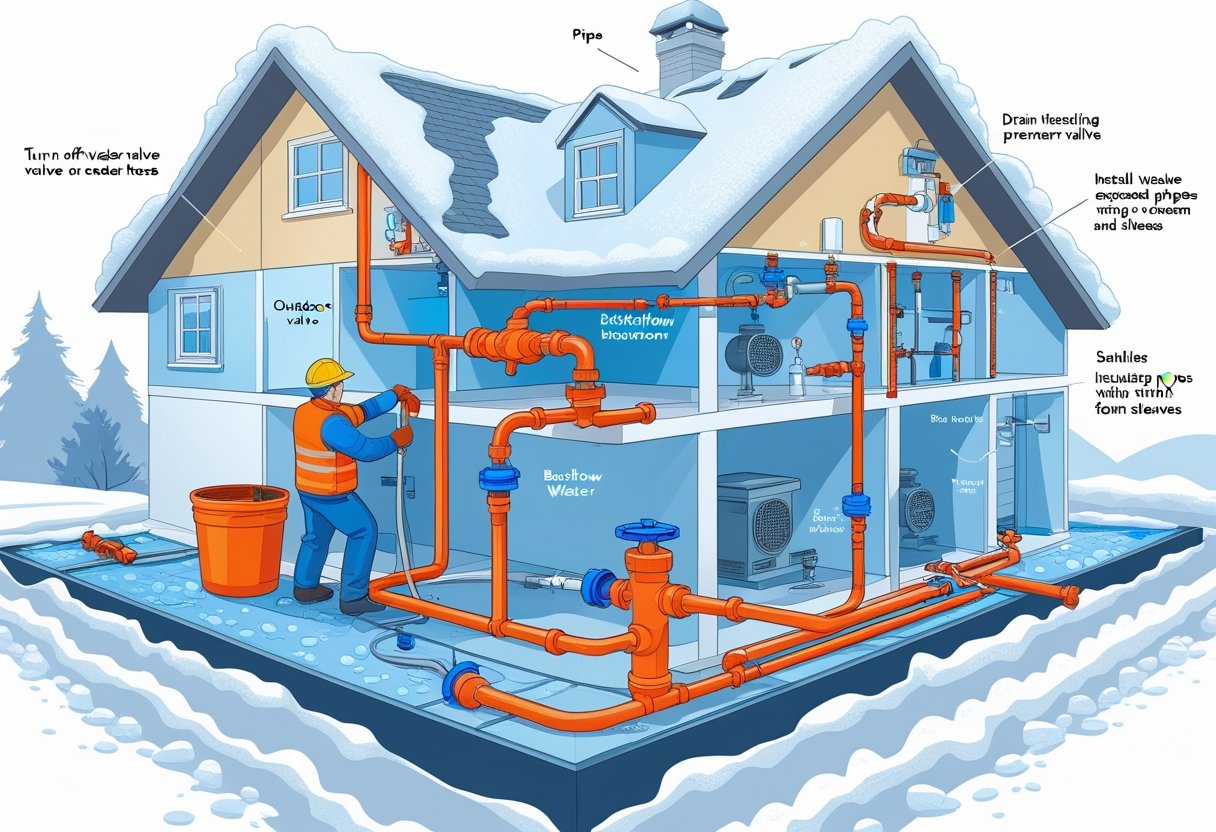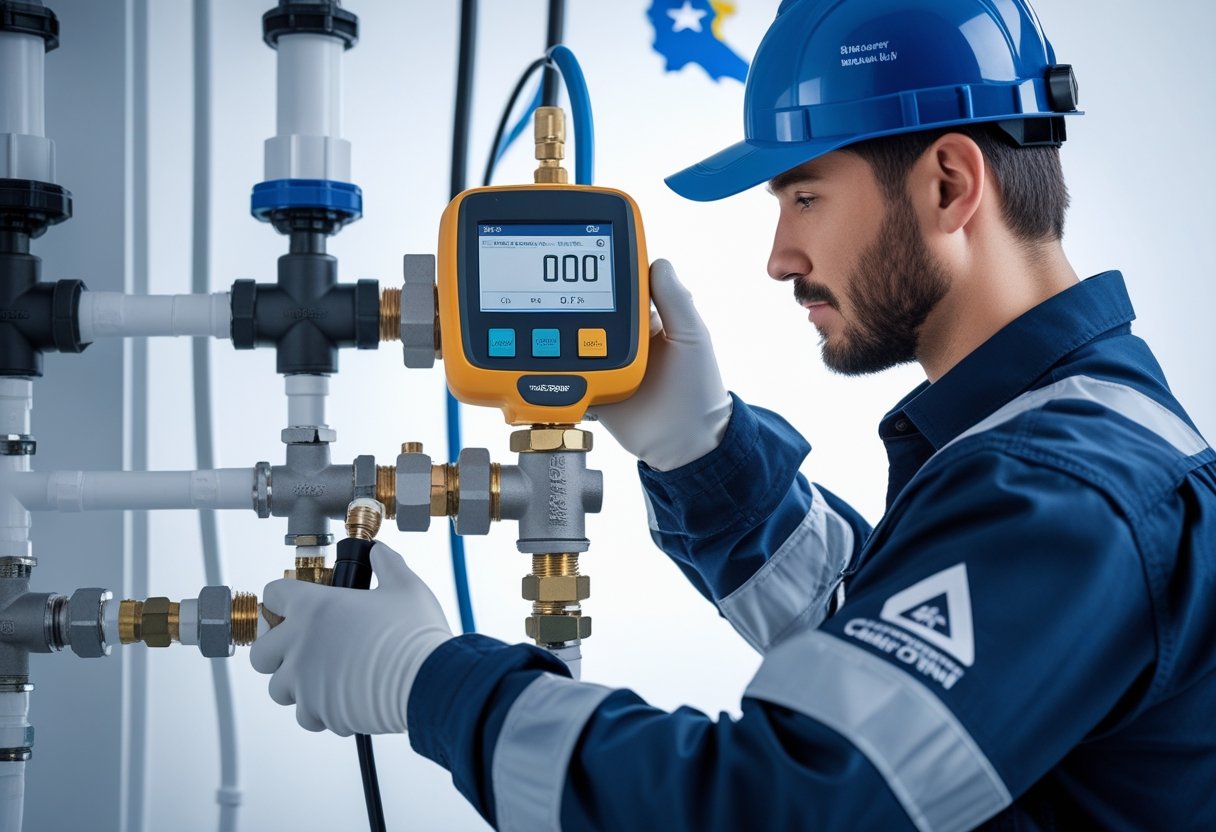As winter approaches, ensuring your plumbing system is prepared for the cold is essential to prevent costly issues, such as backflow. Proper winterization of your plumbing not only safeguards your pipes from freezing but also ensures that your backflow prevention devices operate effectively, protecting your home’s water supply. This proactive approach will help you avoid expensive repairs and potential health risks associated with contaminated water.
At Pacific Backflow, we understand the significance of maintaining your plumbing system throughout winter. Simple steps, such as draining your irrigation lines and insulating your pipes, can make a substantial difference in preventing backflow problems. By taking these precautions, you can enjoy peace of mind knowing your plumbing is ready to withstand harsh winter conditions.
With nearly half a century of experience serving all of San Diego County, Pacific Backflow is committed to helping you protect your home's water supply. Our reliable backflow testing, repairs, and installations ensure your system remains compliant and functional throughout the winter months.
Understanding Backflow and Its Risks
Backflow poses significant risks to your potable water supply, making it essential to understand its causes and potential consequences. By recognizing these factors, you can implement effective prevention strategies.
What Is Backflow?
Backflow occurs when water flows in the opposite direction than intended in a plumbing system. This reversal can happen due to a drop in water pressure or a cross-connection between potable and contaminated water supplies. In such instances, hazardous substances can infiltrate your clean water, compromising its safety. The installation of a backflow preventer is vital for averting these incidents, as it ensures water flows only in the intended direction. Regular maintenance and testing of these devices are crucial to ensure they function properly and comply with local regulations.
Common Causes of Backflow In Plumbing Systems
Several factors can lead to backflow in plumbing systems. One common cause is a sudden drop in water pressure, often triggered by broken water mains or excessive demand during peak usage times. This creates a vacuum effect, pulling contaminated water back into the clean supply. Another contributor is cross-connections, which occur when non-potable water sources, like irrigation systems, are improperly linked to drinking water systems. Inadequate backflow prevention measures further exacerbate this problem. To safeguard your home, it's essential to regularly check for cross-connections and ensure that backflow preventers install correctly.
Consequences of Backflow Contamination
Backflow contamination can result in severe health risks and property damage. When unsafe water enters your supply, it can introduce harmful bacteria, chemicals, and other contaminants, potentially leading to gastrointestinal illnesses and chemical exposure. Contaminated water can also result in plumbing system damage or costly repairs. Local authorities may impose fines if backflow prevention devices are not functional or up to code. Awareness and proactive measures can prevent these adverse effects. Regular testing and maintenance from a qualified service provider, like Pacific Backflow, ensures compliance with safety standards and protects your water supply from contamination.
Why Winterizing Plumbing Is Essential for Backflow Prevention
Winterizing your plumbing is crucial in preventing backflow issues during colder months. Proper preparation safeguards your water supply and reduces risks associated with frozen pipes and contamination.
How Cold Weather Impacts Plumbing and Backflow Preventers
Cold temperatures can lead to frozen pipes and malfunctioning backflow preventers. When water inside a preventer freezes, it can expand, causing stress and potential failure of the device. This can result in backflow contamination, where non-potable water mixes with your potable supply.
Additionally, if a backflow preventer is damaged due to freezing, it may not function correctly when needed. This can expose your clean water supply to harmful contaminants, making winterization essential for safety and compliance.
Preventing Frozen Backflow Preventers
To prevent your backflow preventer from freezing, start by insulating all exposed pipes. Use foam pipe insulation or heat tape for added protection. Make sure to drain outdoor faucets and sprinkler systems to eliminate trapped water that could freeze.
It's also wise to schedule regular inspections and testing of your backflow equipment, especially as winter approaches. Pacific Backflow offers reliable backflow testing services to ensure your prevention systems function efficiently. Proper winterization helps maintain compliance with local regulations and prevents costly repairs in the spring.
Health and Safety Risks of Inadequate Winterization
Failure to winterize your plumbing can pose serious health risks. Frozen and burst pipes can lead to water contamination, affecting your overall water quality. This can be particularly dangerous if harmful substances enter your system, impacting your family's health.
Inadequate winterization not only compromises water quality but may also result in significant repair costs. It's crucial to take proactive measures to ensure your backflow preventer and plumbing are winter-ready. Regular maintenance provided by professionals like Pacific Backflow minimizes risks and enhances the safety of your water supply.
Step-by-Step Guide to Winterizing Plumbing for Backflow Protection
Winterizing your plumbing system is crucial for preventing issues like a frozen backflow preventer. By following specific steps, you can protect your water supply and ensure your backflow prevention system operates smoothly during colder months.
Shutting Off Main Water Supplies
Begin by locating your main water shut-off valve. This valve is usually found near where the water line enters your home. Turn it clockwise until it's completely shut off. This step is vital, as it prevents water from entering the pipes, reducing the risk of build-up and freezing.
Make sure to inform other household members about the shut-off. You should also consider shutting off any additional valves for outdoor spigots if applicable. Always double-check to ensure water flow has stopped entirely before proceeding to the next step.
Draining Outdoor Faucets and Pipes
Next, drain all outdoor faucets and pipes to prevent freezing. Start by opening the faucet to allow any remaining water to flow out. If you have a hose attached, detach it and fully drain it as well.
For systems with in-ground irrigation or additional fixtures, locate the drain valves and open them. Allow sufficient time for the entire system to empty. Use a wet/dry vacuum to remove water from low points if necessary. This helps to ensure there is no moisture left that could freeze and cause damage.
Preparing and Draining the Backflow Preventer
Your backflow preventer is a key component of your plumbing system, and it requires special attention. After shutting off the main supply and draining the system, locate the backflow preventer, usually situated near your water supply.
Follow manufacturer instructions to safely drain the device. This may involve removing drain plugs or valves, allowing water to exit completely. Inspect the preventer for any signs of damage or corrosion. If unsure, you can consult professionals like Pacific Backflow for expert assistance.
Applying Insulation and Weatherproofing
After draining your plumbing and backflow preventer, it's time to protect exposed pipes. Use pipe insulation, foam tubes, or heat tape to wrap any vulnerable sections. Pay special attention to areas like basements and attics where cold air can impact pipes.
Consider weatherproofing exterior faucets by adding insulated covers. This extra layer prevents freezing, ensuring your backflow prevention stays functional throughout the winter. For additional security, consult Pacific Backflow about custom-fitted protection solutions to safeguard your backflow device.
Taking these steps will effectively winterize your plumbing and prevent backflow issues caused by freezing temperatures.
Best Practices and Tools for Effective Winterization
Winterizing your plumbing systems is essential to prevent issues such as backflow and frozen pipes. By implementing specific strategies and using the right tools, you can safeguard your plumbing and ensure its reliability during colder months.
Choosing the Right Insulation Materials
Selecting appropriate insulation materials is crucial for effective winterization. Opt for foam pipe insulation or fiberglass sleeves, as they provide excellent thermal protection. Ensure the insulation is thick enough to withstand local temperature fluctuations.
For areas prone to severe cold, consider using heat-reflective insulation, which can further enhance efficiency. Pay special attention to vulnerable sections, such as exterior walls and attics, where pipes are more susceptible to freezing.
Using insulated wraps on backflow preventers is also wise. This protects against freezing and maintains system integrity, which is vital for preventing backflow issues.
Using Heat Tape and Tracing Cables
Heat tape and tracing cables serve as excellent tools to prevent freezing in problem areas. Install heat tape around exposed pipes, particularly those in unheated spaces. This electrical tape emits gentle heat, keeping the temperature above freezing.
Make sure to follow the manufacturer's installation recommendations carefully. Avoid overlapping the tape, as it can create hot spots and lead to damage.
For longer pipes, consider using electric tracing cables, which can be plugged in to provide consistent warmth. This approach helps protect critical components, including backflow preventers, ensuring they function correctly during freezing conditions.
Installing Insulated Enclosures
For outdoor plumbing components, insulated enclosures can make a significant difference. Constructing a weather-tight box or shelter around backflow preventers helps maintain a stable temperature. Ensure enclosures are well-ventilated to prevent condensation buildup inside.
Use materials like foam board or insulated plywood for the enclosure. Adding a heat source, such as a light bulb, can also help maintain warmth when temperatures drop significantly. These enclosures are particularly useful in protecting sensitive plumbing items from extreme winter weather.
Utilizing Automated Monitoring Systems
Implementing automated monitoring systems can enhance your winterization efforts. These systems can alert you to temperature drops, enabling prompt action to remedy potential freeze risks.
Consider investing in smart sensors that monitor pipe temperatures and send notifications to your smartphone or computer. This proactive approach allows you to address any issues before they escalate, protecting your entire plumbing system, including backflow preventers.
By taking these steps and using the right tools, you significantly reduce the risk of plumbing failures during winter. If you need assistance with backflow preventers, contact Pacific Backflow for reliable service throughout San Diego County.
Professional Maintenance and Year-Round Protection
Maintaining your plumbing system is essential for preventing backflow and ensuring a safe water supply. Focus on regular inspections and proactive maintenance to safeguard your potable water.
Inspecting and Testing Backflow Prevention Devices
Regular inspection and testing of your backflow prevention devices are crucial. Schedule annual backflow testing to check that your devices function correctly and meet local regulations. This process is essential for maintaining water quality and safety.
Pacific Backflow offers certified technicians who conduct comprehensive testing and submit compliance reports on your behalf. Should any device malfunction, immediate intervention is vital to protect your system and avert costly repairs.
Scheduling Regular Professional Check-Ups
Plan for regular professional check-ups to maintain optimal plumbing performance. This helps in identifying potential issues before they escalate. A thorough evaluation can pinpoint hidden leaks, damaged pipes, or faulty backflow preventers.
Consider using a service like Pacific Backflow, which specializes in routine maintenance and quick response times. Regular check-ups ensure your plumbing stays compliant and efficient throughout the year.
Long-Term Care for Potable Water Safety
Long-term care of your plumbing system is essential for ensuring continuous protection of potable water. Implement preventive measures such as installing backflow preventer cages to deter theft and vandalism.
It’s crucial to replace outdated or malfunctioning backflow preventers. Upgrading your equipment helps maintain compliance with safety standards and keeps your water supply secure. Partnering with a reliable service like Pacific Backflow ensures your plumbing is monitored and maintained effectively over time.
Frequently Asked Questions
Understanding winterization is essential to prevent backflow issues in plumbing. This section addresses common questions regarding the specifics of insulating pipes, preventing freezing, and identifying signs of failure in backflow prevention systems.
What steps should be taken to insulate pipes for winter?
To insulate your pipes effectively, start by using foam pipe insulation or heat tape on exposed sections. Ensure that the insulation covers all areas where cold air might reach the pipes, particularly in unheated spaces like attics or basements.
How can one prevent pipes from freezing and bursting in cold weather?
Keep your home heated adequately, even when you're away. Open cabinet doors under sinks to allow warmer air to circulate around the plumbing. Draining outdoor faucets and adding insulation to vulnerable areas are also effective measures.
Which valves should be shut off to avoid backflow during winter?
Shut off the main water supply valve and any supply valves serving outdoor faucets or irrigation systems. This prevents water from entering the system and subsequently freezing, which can lead to backflow issues.
Are there specific antifreeze products advisable for plumbing systems?
Use only non-toxic, plumbing-safe antifreeze products specifically designed for residential use. This helps prevent freezing without contaminating your water supply, making it safe for indoor plumbing applications.
What is the recommended method for draining pipes to prevent freezing?
Start by turning off the main water supply and opening all faucets to allow water to drain. Use a wet/dry vacuum to remove residual water from the pipes, especially in areas where freezing is common.
What are the signs that backflow prevention has failed, and immediate action is needed?
Look for signs such as unusual pressure changes, discolored water, or the presence of contaminants in your potable water supply. If you suspect a failure, contact a professional for immediate inspection and service to ensure water safety. For reliable backflow testing and repairs, consider reaching out to Pacific Backflow, serving all of San Diego County.











